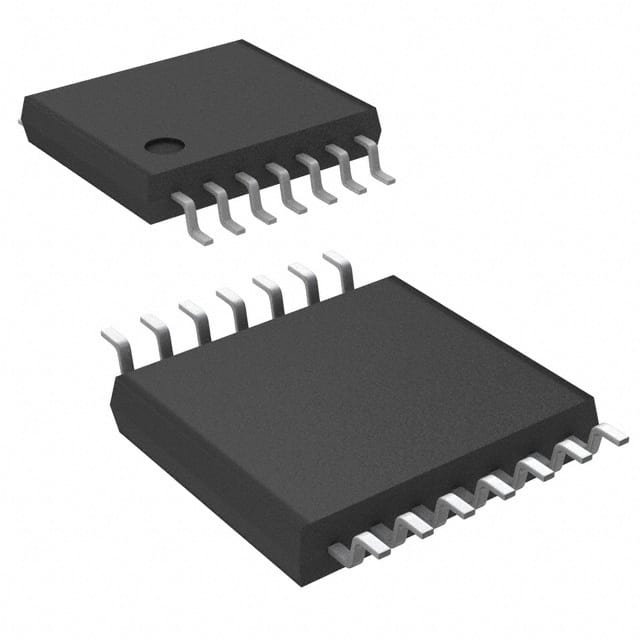LM324PWG4
Product Overview
Category: Integrated Circuit (IC)
Use: Operational Amplifier
Characteristics: - Low power consumption - Wide supply voltage range - High gain bandwidth product - Low input offset voltage - Large output voltage swing - High common-mode rejection ratio
Package: TSSOP-14 (Thin Shrink Small Outline Package)
Essence: The LM324PWG4 is a quad operational amplifier that is widely used in various electronic circuits due to its versatile characteristics and low power consumption.
Packaging/Quantity: The LM324PWG4 is typically sold in reels containing 2500 units.
Specifications
The LM324PWG4 has the following specifications:
- Supply Voltage Range: 3V to 32V
- Input Offset Voltage: 2mV (maximum)
- Gain Bandwidth Product: 1MHz (typical)
- Input Bias Current: 20nA (maximum)
- Output Short Circuit Current: 40mA (maximum)
- Operating Temperature Range: -40°C to +125°C
Detailed Pin Configuration
The LM324PWG4 has a TSSOP-14 package with the following pin configuration:
___________
VCC | 1 14 | OUT1
IN1- | 2 13 | IN4+
IN1+ | 3 12 | IN4-
IN2- | 4 11 | OUT4
IN2+ | 5 10 | GND
IN3- | 6 9 | OUT3
IN3+ | 7 8 | OUT2
‾‾‾‾‾‾‾‾‾‾‾‾
Functional Features
The LM324PWG4 offers the following functional features:
- Low power consumption makes it suitable for battery-powered applications.
- Wide supply voltage range allows for flexibility in various circuit designs.
- High gain bandwidth product enables accurate amplification of signals.
- Low input offset voltage ensures precise signal processing.
- Large output voltage swing provides a wide dynamic range.
- High common-mode rejection ratio minimizes interference from common-mode signals.
Advantages and Disadvantages
Advantages: - Versatile characteristics make it suitable for a wide range of applications. - Low power consumption extends battery life in portable devices. - Compact TSSOP-14 package saves board space. - Cost-effective solution for many electronic circuits.
Disadvantages: - Limited gain bandwidth product compared to some specialized operational amplifiers. - Input offset voltage may require additional calibration in certain precision applications.
Working Principles
The LM324PWG4 is an operational amplifier that amplifies the difference between its two input terminals. It operates based on the principles of differential amplification and feedback control. The input signal is amplified by a high gain, and the amplified output is fed back to the input through a feedback network to stabilize the overall amplification and achieve desired circuit behavior.
Detailed Application Field Plans
The LM324PWG4 finds extensive use in various application fields, including but not limited to: 1. Audio amplification circuits 2. Signal conditioning circuits 3. Voltage and current measurement circuits 4. Active filters 5. Oscillators 6. Comparators 7. Sensor interfaces 8. Motor control circuits
Detailed and Complete Alternative Models
Some alternative models to the LM324PWG4 include: - LM358 - LM741 - TL072 - MCP6004 - AD822
These alternatives offer similar functionality and can be used as substitutes depending on specific requirements and design constraints.
In conclusion, the LM324PWG4 is a versatile quad operational amplifier with low power consumption and various useful characteristics. Its wide range of applications, compact package, and cost-effectiveness make it a popular choice in the field of electronics.
Word count: 511
Senaraikan 10 soalan dan jawapan biasa yang berkaitan dengan aplikasi LM324PWG4 dalam penyelesaian teknikal
Sure! Here are 10 common questions and answers related to the application of LM324PWG4 in technical solutions:
Q: What is LM324PWG4? A: LM324PWG4 is a quad operational amplifier (op-amp) integrated circuit commonly used in various electronic applications.
Q: What is the voltage supply range for LM324PWG4? A: The voltage supply range for LM324PWG4 is typically between 3V and 32V.
Q: Can LM324PWG4 be used as a comparator? A: Yes, LM324PWG4 can be used as a comparator by utilizing one of its op-amps in open-loop configuration.
Q: What is the maximum output current of LM324PWG4? A: The maximum output current of LM324PWG4 is around 20mA per op-amp.
Q: Is LM324PWG4 suitable for low-power applications? A: Yes, LM324PWG4 is suitable for low-power applications as it has a low quiescent current consumption.
Q: Can LM324PWG4 operate in single-supply configurations? A: Yes, LM324PWG4 can operate in single-supply configurations by connecting the non-inverting input to a reference voltage.
Q: What is the typical gain bandwidth product of LM324PWG4? A: The typical gain bandwidth product of LM324PWG4 is around 1 MHz.
Q: Can LM324PWG4 be used in audio applications? A: Yes, LM324PWG4 can be used in audio applications such as audio amplifiers and equalizers.
Q: Does LM324PWG4 have built-in protection features? A: Yes, LM324PWG4 has built-in protection features like short-circuit protection and thermal shutdown.
Q: What are some common applications of LM324PWG4? A: Some common applications of LM324PWG4 include signal conditioning, voltage amplification, active filters, and instrumentation amplifiers.
Please note that the answers provided here are general and may vary depending on specific datasheet specifications and application requirements.


